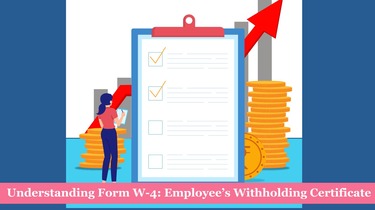
Form W-4 or Employee’s Withholding Certificate record the correct federal tax withheld amount of employees. Employees fill W-4 under the guidance of employers of managerial bodies of any particular corporation. It is the employer’s responsibility to maintain the W-4 Form’s confidential status.
Being an employee of any particular firm or organization also comes with many roles and responsibilities. These duties are certain and have to be performed to stay compliant and trusted in the organization’s sight. Apart from performing job profile suggestive roles, employees must stay compliant with prominent federal suggested tax forms. Compliance with such regulatory bodies allows employees to stay accountable in the sight of law and order.
What is Form W-4: Employee Withholding Certificate?
Form W-4 indicates an employee’s filing status, multiple job adjustments, the aggregate amount of credits and other incomes, and any principal amount to be withheld from any paycheck to calculate the amount of federal income tax to deduct and withhold from employees’ final paycheck. Employees or new employees working in any particular firm or organization should file Form W4. Form W-4 is an intensively detailed taxation form that guides employees to sort their finances persistently and proceed with the filling process.
Employees file this form under the guidance of employers. They monitor and make sure the intact filing status of the form. Form W2 instructs employers how much to withhold from their employee’s paycheck.
Purpose and Components of Form W-4
What is the purpose of a W-4 form?
Form W-4 is to record the correct federal tax withheld amount of employees. IRS monitors the status of withholdings precisely. If the amount of withholding is quite low, then that individual would owe an amount to be paid as tax while filing for tax returns or paying penalties. If the amount withheld is high, that individual would get a due refund. In the course of financial or personal changes, the form’s update or refiling should be considered.
The components of Form W-4 generally include basic directory information like name, address, contact information, etc. Additionally, information regarding the financial aspects of an employee is recorded in an elaborative manner. Under financial information, the form is designed to extract the basic breakout of paychecks and other additional incomes of an employee. The amount would depend on the employee’s marital status, the number of dependents, and personal withholding preferences.
Who Should File the Form W-4? Employers should file Form W-4 to inform their respective employers about the exact and correct amount of taxes to be withheld. The incorrect filling of form W-4 could lead an employee to owe up taxes while filing for returns.
When to file Form W-4? Employees need to submit Form W-4 once they begin a new job. Yet, in case of any changes or developments in marital status, a number of dependents, and withholding preferences, an employee has to file again.
List of penalties under the W-4 form
The IRS suggests employees fill out form W4 on the first day or a day before their employment begins at a particular organization. Employees claiming excess withholding alternatives on Form W-4 would be held accountable for a civil penalty of $500. Criminal penalties also apply when an individual willfully reports false information or fails to supply withholding information. Primary stakeholders of Form W-4 are entitled to claim exemption dependency for themselves and their respective dependents.
Guidelines suggested by IRS for form W-4
The IRS suggests employees file Form W4 in a precise manner. Precisely, in terms of timing and severity. IRS expects employees to file Form W4 carefully and rightfully while reporting correct insights and information. While filing Form W4, IRS intakes basic directory information of employees like name, home address, social security number, marital status, allowances, and signatures. Yet to conform to the status of an employee’s residential documents like a green card or US passport is considered an affirmative basis.
Form W-4 Exception
Nonresident alien exception denotes that an alien citizen can claim personal allowances on Form W-4 only if they are spouse to a US-based citizen. Nonresident citizens from territories like Canada, Mexico, South Korea, India, American Samoa, Northern Mariana Islands, Barbados, Hungary, and Jamaica are eligible for this exception privilege. This exception would allow nonresidents to claim W4 benefits or dependency benefits. The child of a nonresident and a US resident couple can also claim W4 dependency benefits. The child qualifies as a dependent under the IRS rules.
Territories like Canada, Mexico, South Korea, India, American Samoa, and the Northern Mariana Islands have the same rules for nonresident dependents. In contrast, Barbados, Hungary, and Jamaica have taxpayer benefits associated with the academic spectrum. Factors around residency, taxation, and attaining claims are submerged in this territory. Students must file Form W4 and W9 to claim their benefits and be taxed as a resident.
Major changes in the Form W-4
Implementing the Tax Cuts and Jobs Act (TCJA 2017) has influenced the working of Form W4. It has removed the clause of personal exemptions and has increased the standard deduction parameters.
In the following year, a change in the withholding table is made. This table is used to calculate and estimate the federal income tax withholding. With other presented information, withholding plays a crucial role in the process of completion of F1orm W4. The form’s length is extended from a half-page to a full one. The easier and more directive sections are organized in the form. Three main sections in the form determine the withholding of information. Only after meeting certain requirements can an individual claim exempt status.




